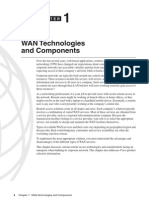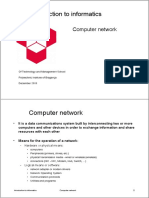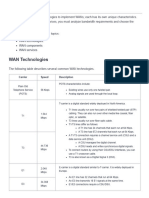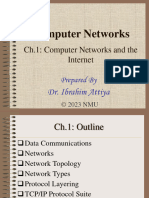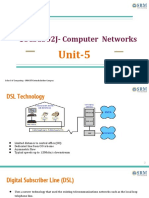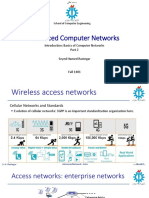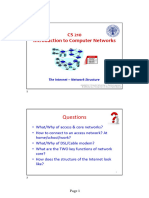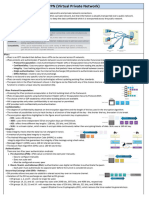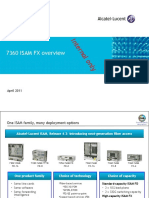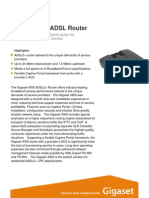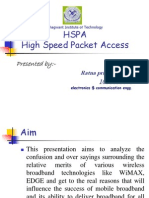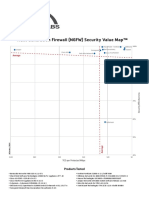Professional Documents
Culture Documents
WAN Connectivity Options: Dedicated: Leased Line: T1/E1: T3/E3
WAN Connectivity Options: Dedicated: Leased Line: T1/E1: T3/E3
Uploaded by
Ham DokOriginal Description:
Original Title
Copyright
Available Formats
Share this document
Did you find this document useful?
Is this content inappropriate?
Report this DocumentCopyright:
Available Formats
WAN Connectivity Options: Dedicated: Leased Line: T1/E1: T3/E3
WAN Connectivity Options: Dedicated: Leased Line: T1/E1: T3/E3
Uploaded by
Ham DokCopyright:
Available Formats
WAN Connectivity Options
Dedicated : Leased Line : T1/E1 : ▪ Point-to-point lines that could be leased from a service provider
T3/E3 ▪ The organization pays a monthly lease fee to the ISP to use the line.
▪ Available in different fixed capacities
▪ Generally priced based on the bandwidth required and the distance
between the two connected points.
▪ Systems used to define the digital capacity of the link :
▪ T-carrier : Used in North America. ▪ T1 links up to 1.544 Mbps
Traditional : ▪ T3 links up to 43.7 Mbps.
▪ Too expensive ▪ E-carrier : Used in Europe. ▪ E1 links up to 2.048 Mbps
▪ Limited bandwidth ▪ E3 links up to 34.368 Mbps.
Circuit Switched : PSTN : ▪ Public Service Telephone Network
▪ Provided by (PSTN) carriers. ▪ Dialup WAN access used the PSTN as its WAN connection.
▪ CPE to CO is copper media. ▪ Could transport binary computer data through the voice
▪ Establishes a dedicated telephone network using a voiceband modem.
Circuit (or channel) between ▪ The physical characteristics of the local loop and its
endpoints before the users can connection to the PSTN limit the rate to less than 56 kbps.
Switched : communicate.
▪ All communication uses the same path. ISDN : ▪ Integrated Services Digital Network
▪ Enables the PSTN local loop to carry digital signals.
▪ Provides higher capacity than dialup access.
▪ Data rates from 45 Kbps to 2.048 Mbps.
Packet Switched : Frame : ▪ Simple Layer 2 (NBMA) WAN technology .
▪ Most commonly implemented. Relay ▪ used to interconnect enterprise LANs.
▪ Segments traffic data into packets that ▪ Creates PVCs uniquely identified by a (DLCI).
are routed over a shared network.
▪ Much less expensive and more flexible ATM : ▪ Stands for Asynchronous Transfer Mode.
than Circuit switched. ▪ Can transfer voice/video/data through private/public networks.
▪ Built on a cell-based architecture rather than on a frame-based.
▪ ATM cells are always a fixed length of 53 bytes.
Note: Frame relay and ATM networks have been largely replaced by faster
Metro Ethernet and internet-based solutions.
Dedicated : Broadband : Fiber : ▪ ISPs use fiber-optic infrastructures to transport user data.
▪ Fiber cables are far superior in speed and distance to copper cables.
▪ TWO OSI layer 1 standards available to service providers:
SDH - Synchronous Digital Hierarchy : the global standard.
SONET-Synchronous Optical Networking :North American standard.
▪ SDH/SONET define how to transfer multiple data, voice, and video
communications over optical fiber.
▪ Dense Wavelength Division Multiplexing (DWDM) : newer techno-
logy that increases the data-carrying capacity of SDH and SONET.
Modern : Switched : Packet Switched : Ethernet : ISPs now offer Ethernet WAN service using fiber-optic cabling.
▪ Faster WAN Ethernet WAN service can be any of the following:
▪ More flexible •Metropolitan Ethernet (Metro E)
▪ More options •Ethernet over MPLS (EoMPLS)
•Virtual Private LAN Service (VPLS)
Ethernet WANs are now replacing the traditional WAN links.
MPLS : ▪ Multiprotocol Label Switching
▪ High-performance service
provider WAN routing technology.
▪ Interconnect clients without regard to access method or payload.
▪ Supports a variety of client access methods (Ethernet,DSL, Cable .. )
▪ Can encapsulate all types of protocols including IPv4/IPv6 traffic.
Internet-Based : Broadband : Wired : DSL : Digital Subscriber Line
VPN ▪ High-speed, always-on, connection technology
▪ Uses existing twisted-pair telephone lines to provide IP services to users.
▪ Categorized as either : Asymmetric DSL or Symmetric DSL
ADSL (ADSL2+) : provide higher downstream than upload bandwidth.
Modern WAN connections SDSL : provides the same capacity in both directions.
▪ Rates dependent on the actual length of the local loop and cabling.
DSL Connections :
▪ Service providers deploy DSL connections in the local loop.
▪ The connection is set up between the DSL modem and the DSL access multiplexer (DSLAM).
▪ The DSL modem converts the Ethernet signals from the teleworker device to a DSL signal, which is transmitted to
DSL access multiplexer (DSLAM) at the provider location.
▪ DSLAM is located at the Central Office (CO) of the ISP and concentrates connections from multiple DSL subscribers.
▪ DSL is not a shared medium. Each user has a separate direct connection to the DSLAM.
▪ Adding users to the DSLAM does not impede performance.
DSL and PPP :
▪ ISPs use PPP as the Layer 2 protocol for broadband DSL connections.
▪ PPP can be used to authenticate the subscriber.
▪ PPP can assign a public IPv4 address to the subscriber.
▪ PPP provides link-quality management features.
▪ There are two ways PPP over Ethernet (PPPoE) can be deployed:
▪ Host with PPoE Client : The PPPoE client software communicates
with the DSL modem using PPPoE and the modem communicates
with the ISP using PPP.
▪ Router PPPoE Client : The router is the PPPoE client and obtains
its configuration from the provider.
Cable Technology :
▪High-speed always-on connection technology.
▪ Uses a coaxial cable from the cable company to provide IP services to users.
▪ The optical node converts RF signals to light pulses over fiber-optic cable.
▪ The fiber media enables the signals to travel over long distances to the provider headend
where a Cable Modem Termination System (CMTS) is located.
▪ The headend contains the databases needed to provide internet access.
▪ The CMTS is responsible for communicating with the cable modems.
Note: All the local subscribers share the same cable bandwidth. As more users join the service, available bandwidth
may drop below the expected rate.
Optical Fiber : Many municipalities, cities, and providers install fiber-optic cable to the user location.
▪ This is commonly referred to as Fiber to the x (FTTx) and includes the following:
▪ Fiber to the Home (FTTH) : Fiber reaches the boundary of the residence.
▪ Fiber to the Building (FTTB) : Fiber reaches the boundary of the building.
▪ Fiber to the Node/Neighborhood (FTTN) : Fiber reaches an optical node that converts optical signals to
a format acceptable for twisted pair or coaxial cable to the premise.
Note: FTTx can deliver the highest bandwidth of all broadband options.
Wireless : Municipal Wi-Fi : Municipal wireless networks are available in many cities providing high-speed internet access for free,
▪ Wireless or for substantially less than the price of other broadband services.
technology
uses the
unlicensed
Cellular : Used to connect devices to the internet using radio waves to communicate through a nearby mobile phone tower.
radio spectrum ▪ Common cellular technologies : 3G, 4G, 5G and Long-Term Evolution (LTE).
to send and
▪ Less expensive Satellite Internet : Typically used by rural users or in remote locations where cable and DSL are not available.
▪ A router connects to a satellite dish which is pointed to a service provider satellite in Geosynchronous orbit.
▪ Trees and heavy rains can impact the satellite signal.
WiMAX : Worldwide Interoperability for Microwave Access.
▪ Provides high-speed broadband service with wireless access.
▪ Provides broad coverage like a cell phone network rather than through small Wi-Fi hotspots.
You might also like
- 001 2023 CC Domain 4 Study Guide by ThorTeaches - Com v1.1Document53 pages001 2023 CC Domain 4 Study Guide by ThorTeaches - Com v1.1sasijo9863No ratings yet
- Concise Guide to OTN optical transport networksFrom EverandConcise Guide to OTN optical transport networksRating: 4 out of 5 stars4/5 (2)
- RADAR BRIDGE MASTER ''E'' Series Radar Ship's ManualDocument161 pagesRADAR BRIDGE MASTER ''E'' Series Radar Ship's Manualtoumassis_p100% (11)
- CST Product CatalogDocument66 pagesCST Product Catalogirshan1986100% (1)
- Cheat Sheet Network ProprofsDocument38 pagesCheat Sheet Network Proprofsleecmyd100% (1)
- Luminex Network PresentationDocument49 pagesLuminex Network PresentationRoger BecalliNo ratings yet
- 1830 PSS Part Number ListingDocument16 pages1830 PSS Part Number Listingcarlzhang75100% (1)
- Wan ConceptDocument27 pagesWan ConceptVichheka SouenNo ratings yet
- Network ProtocolDocument14 pagesNetwork Protocoldeath noteNo ratings yet
- Lecture - 03 Section 5B - Chapter 1 - 30 Aug 2022Document19 pagesLecture - 03 Section 5B - Chapter 1 - 30 Aug 2022Hafsa NajeebNo ratings yet
- Unit-1.5 Guided and Unguided Transmission MediaDocument31 pagesUnit-1.5 Guided and Unguided Transmission Mediabffs814No ratings yet
- Chapter 12Document42 pagesChapter 12zakiya hassanNo ratings yet
- Lecture 3 - Categories of Computer NetworksDocument8 pagesLecture 3 - Categories of Computer NetworksYahya RamadhanNo ratings yet
- Accessing Wan Connection of WansDocument35 pagesAccessing Wan Connection of WansZaenal abidinNo ratings yet
- IT2250 Unit 4 AssignmentDocument3 pagesIT2250 Unit 4 AssignmentAnas ToufeeqNo ratings yet
- Public Switched Data NetworkDocument8 pagesPublic Switched Data NetworkMichael David CaparazNo ratings yet
- WAN (Wide Area Network)Document1 pageWAN (Wide Area Network)Ham DokNo ratings yet
- CN Module 1Document99 pagesCN Module 1Girish SeemakurthiNo ratings yet
- Notice Wan ConnectionDocument17 pagesNotice Wan Connectionsaidssan340No ratings yet
- WAN Technologies and Components: H A P T E RDocument39 pagesWAN Technologies and Components: H A P T E RRohit AroraNo ratings yet
- Lesson 1-4 Wan TechDocument34 pagesLesson 1-4 Wan TechLalit KR NeerajNo ratings yet
- Introduction To Informatics: Computer NetworkDocument26 pagesIntroduction To Informatics: Computer NetworkRui CostaNo ratings yet
- 10.1.2 WAN Concept FactsDocument5 pages10.1.2 WAN Concept Factsdezaree35No ratings yet
- WAN - Internet - PPPoEDocument46 pagesWAN - Internet - PPPoEblue.jupiter9x154No ratings yet
- Bluetooth TechnologyDocument26 pagesBluetooth TechnologySayan RoyNo ratings yet
- Internet Access Via Cable TVDocument23 pagesInternet Access Via Cable TVAjay Nath S ANo ratings yet
- Unit IiDocument45 pagesUnit IiVENU VNo ratings yet
- ST 11 Teknologi-Jaringan-Akses PDFDocument53 pagesST 11 Teknologi-Jaringan-Akses PDFSerpi PabungaNo ratings yet
- Lecture 2 Computer NetworksDocument31 pagesLecture 2 Computer Networksahmedehab1772002No ratings yet
- REVIEWER FINALS DatacommsDocument4 pagesREVIEWER FINALS DatacommsNikko AntesNo ratings yet
- PSDN and IsdnDocument32 pagesPSDN and IsdnLYNN JANE JANIERNo ratings yet
- Unit 3Document34 pagesUnit 3vishalnishad5238No ratings yet
- Internet Access Via Cable TVDocument23 pagesInternet Access Via Cable TVRevanth ReddyNo ratings yet
- 1SCS105 Wired-Wireless - DOC ONEDocument12 pages1SCS105 Wired-Wireless - DOC ONEmuhwezi jonasNo ratings yet
- Lecture 6 - Networking DevicesDocument7 pagesLecture 6 - Networking DevicesNyambura KinyuaNo ratings yet
- Chapter 02 03Document53 pagesChapter 02 03Kjell15100% (2)
- 1.4 2022 ThorTeaches CC Study Guides Chapter 4 v1.1Document53 pages1.4 2022 ThorTeaches CC Study Guides Chapter 4 v1.1Sameer NaikNo ratings yet
- Unit2 (Latest) 2Document25 pagesUnit2 (Latest) 2Ebad AhmedNo ratings yet
- DATADocument7 pagesDATALaurice MiyanoNo ratings yet
- UNIT 2-SCSA1502-Underlying LAN ConceptsDocument215 pagesUNIT 2-SCSA1502-Underlying LAN ConceptsG.AkshayaNo ratings yet
- 9500MXC Data SheetDocument2 pages9500MXC Data SheetKhaled Al-BassamNo ratings yet
- Ch.16 WANsDocument25 pagesCh.16 WANsvictorbittar29No ratings yet
- 2023+CC+Domain+4+Study+Guide+by+ThorTeaches Com+v1 1Document51 pages2023+CC+Domain+4+Study+Guide+by+ThorTeaches Com+v1 1Palanivel KNo ratings yet
- Telecommunications and The InternetDocument29 pagesTelecommunications and The InternetRajib HassanNo ratings yet
- Unit 2 Course MaterialDocument49 pagesUnit 2 Course MaterialKISHORE KNo ratings yet
- @chapter 7Document28 pages@chapter 7Silabat AshagrieNo ratings yet
- Unit - II: Information Technology InfrastructureDocument32 pagesUnit - II: Information Technology InfrastructureSwathi JampalaNo ratings yet
- NetworkDocument37 pagesNetworkKavee AbeyNo ratings yet
- Presentation 22Document164 pagesPresentation 22shiraju649No ratings yet
- Chapter 8 SwitchingDocument14 pagesChapter 8 Switchingapi-3738694No ratings yet
- ch3 WiredBroadbandConnectivityDocument51 pagesch3 WiredBroadbandConnectivityYohan FtsadikNo ratings yet
- Unit VDocument190 pagesUnit VNipurn BhaalNo ratings yet
- GE Multilin NetworkingDocument56 pagesGE Multilin NetworkingJonathan Pinilla100% (1)
- AdvNet Intro2 Fall1401Document12 pagesAdvNet Intro2 Fall1401sajoolNo ratings yet
- NetworkingDocument114 pagesNetworkingJay ThakkarNo ratings yet
- Cissp 4Document63 pagesCissp 4gmkontNo ratings yet
- Computer Networks - A Top Down Approach: Notes (Chapters 1, 2, 3, 9)Document69 pagesComputer Networks - A Top Down Approach: Notes (Chapters 1, 2, 3, 9)Joe MamaNo ratings yet
- Ch02 PartIDocument44 pagesCh02 PartIgirm2002No ratings yet
- 03 - Internet StructureDocument11 pages03 - Internet StructureLê Thị Hồng HàNo ratings yet
- Wireless LAN 1Document29 pagesWireless LAN 1ManoharNo ratings yet
- Introduction To Computer Networks and The InternetDocument35 pagesIntroduction To Computer Networks and The Internetvictor peterNo ratings yet
- WirelessDocument5 pagesWirelessHam DokNo ratings yet
- WAN StandardsDocument2 pagesWAN StandardsHam DokNo ratings yet
- VPN+IPsec 2Document2 pagesVPN+IPsec 2Ham DokNo ratings yet
- WAN (Wide Area Network)Document1 pageWAN (Wide Area Network)Ham DokNo ratings yet
- D1s 7360 ISAM FX Overview - 2Document14 pagesD1s 7360 ISAM FX Overview - 2dia3phong100% (1)
- DKclzbOSPLW Beacon 2014 11 02Document2 pagesDKclzbOSPLW Beacon 2014 11 02Inam Ur RehmanNo ratings yet
- Price List TriconDocument26 pagesPrice List TriconferonikaNo ratings yet
- 40 5RT84B Maa2hgDocument14 pages40 5RT84B Maa2hgelectronictdf64No ratings yet
- ZTE 3G UR12 Basic Feature ListDocument59 pagesZTE 3G UR12 Basic Feature ListabuzarshazliNo ratings yet
- Tenda-4G680 DatasheetDocument2 pagesTenda-4G680 DatasheetAlimin WahidNo ratings yet
- Asecentech Limited Internet Work Order1Document1 pageAsecentech Limited Internet Work Order1Md. Salman KabirNo ratings yet
- LEMKEN Cable Guide 2022 enDocument47 pagesLEMKEN Cable Guide 2022 enMaxi Reiter100% (1)
- Data Communication: Cable Modem, ADSL, XDSL and Multi Channel AccessDocument24 pagesData Communication: Cable Modem, ADSL, XDSL and Multi Channel AccessJonald BualNo ratings yet
- 1830 Switch DatasheetDocument4 pages1830 Switch DatasheetAhmed ShetaNo ratings yet
- Gigaset 4300 ADSL RouterDocument7 pagesGigaset 4300 ADSL Routerkrutchfield100% (2)
- 3.2 Identify Common Connector TypesDocument8 pages3.2 Identify Common Connector TypesEd St JamesNo ratings yet
- Guided Transmission MediaDocument6 pagesGuided Transmission MediaKunal MhatreNo ratings yet
- Course 5Document27 pagesCourse 5Trần MạnhNo ratings yet
- Alcatel 7342 Isam OltDocument4 pagesAlcatel 7342 Isam Oltpantod2002100% (1)
- 1640 FoxDocument4 pages1640 FoxÁngeles María Días SalazarNo ratings yet
- Century LinkDocument2 pagesCentury LinkclintdespainNo ratings yet
- HSPA High Speed Packet AccessDocument23 pagesHSPA High Speed Packet AccessPrabhat SharmaNo ratings yet
- Symphony XDocument2 pagesSymphony Xberserker6666No ratings yet
- Reference Guide FTTHDocument116 pagesReference Guide FTTHturbozmejNo ratings yet
- The Gsm/Gprs Modem USER'S Guide ME - TC35i/MC35i Terminal: 1.1 Scope of This ManualDocument0 pagesThe Gsm/Gprs Modem USER'S Guide ME - TC35i/MC35i Terminal: 1.1 Scope of This ManualAdolfo A HerreraNo ratings yet
- Next Generation Firewall (NGFW) Security Value Map™: AverageDocument1 pageNext Generation Firewall (NGFW) Security Value Map™: AveragejlpilaNo ratings yet
- Vsat A TutorialDocument5 pagesVsat A TutorialSalahAL-HakimiNo ratings yet
- Belden® 10GX, CAT6+ Modular Cords - Original - 36191Document6 pagesBelden® 10GX, CAT6+ Modular Cords - Original - 36191Jhonny Rafael Blanco CauraNo ratings yet
- GPON in Telecommunication Network: November 2010Document6 pagesGPON in Telecommunication Network: November 2010Supriya Tenny SamNo ratings yet
- Bacaan OptimasiDocument4 pagesBacaan Optimasialdous rogerNo ratings yet





















